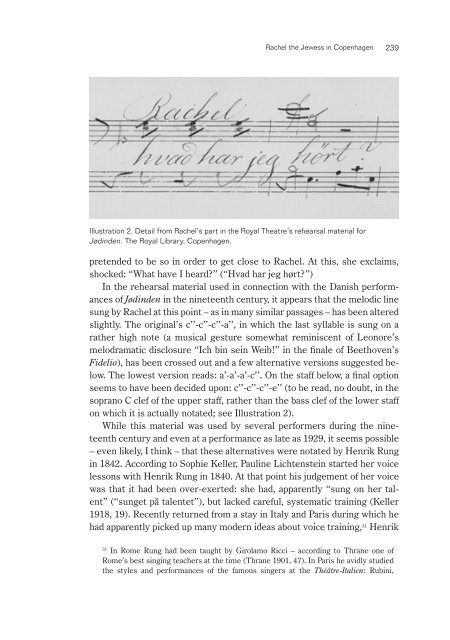Opera on the Move in the Nordic Countries during the Long 19th ...
Opera on the Move in the Nordic Countries during the Long 19th ...
Opera on the Move in the Nordic Countries during the Long 19th ...
Create successful ePaper yourself
Turn your PDF publications into a flip-book with our unique Google optimized e-Paper software.
Rachel <strong>the</strong> Jewess <strong>in</strong> Copenhagen<br />
Illustrati<strong>on</strong> 2. Detail from Rachel’s part <strong>in</strong> <strong>the</strong> Royal Theatre’s rehearsal material for<br />
Jød<strong>in</strong>den. The Royal Library, Copenhagen.<br />
239<br />
pretended to be so <strong>in</strong> order to get close to Rachel. At this, she exclaims,<br />
shocked: “What have I heard?” (“Hvad har jeg hørt?”)<br />
In <strong>the</strong> rehearsal material used <strong>in</strong> c<strong>on</strong>necti<strong>on</strong> with <strong>the</strong> Danish performances<br />
of Jød<strong>in</strong>den <strong>in</strong> <strong>the</strong> n<strong>in</strong>eteenth century, it appears that <strong>the</strong> melodic l<strong>in</strong>e<br />
sung by Rachel at this po<strong>in</strong>t – as <strong>in</strong> many similar passages – has been altered<br />
slightly. The orig<strong>in</strong>al’s c’’-c’’-c’’-a’’, <strong>in</strong> which <strong>the</strong> last syllable is sung <strong>on</strong> a<br />
ra<strong>the</strong>r high note (a musical gesture somewhat rem<strong>in</strong>iscent of Le<strong>on</strong>ore’s<br />
melodramatic disclosure “Ich b<strong>in</strong> se<strong>in</strong> Weib!” <strong>in</strong> <strong>the</strong> f<strong>in</strong>ale of Beethoven’s<br />
Fidelio), has been crossed out and a few alternative versi<strong>on</strong>s suggested below.<br />
The lowest versi<strong>on</strong> reads: a’-a’-a’-c’’. On <strong>the</strong> staff below, a f<strong>in</strong>al opti<strong>on</strong><br />
seems to have been decided up<strong>on</strong>: c’’-c’’-c’’-e’’ (to be read, no doubt, <strong>in</strong> <strong>the</strong><br />
soprano C clef of <strong>the</strong> upper staff, ra<strong>the</strong>r than <strong>the</strong> bass clef of <strong>the</strong> lower staff<br />
<strong>on</strong> which it is actually notated; see Illustrati<strong>on</strong> 2).<br />
While this material was used by several performers dur<strong>in</strong>g <strong>the</strong> n<strong>in</strong>eteenth<br />
century and even at a performance as late as 1929, it seems possible<br />
– even likely, I th<strong>in</strong>k – that <strong>the</strong>se alternatives were notated by Henrik Rung<br />
<strong>in</strong> 1842. Accord<strong>in</strong>g to Sophie Keller, Paul<strong>in</strong>e Lichtenste<strong>in</strong> started her voice<br />
less<strong>on</strong>s with Henrik Rung <strong>in</strong> 1840. At that po<strong>in</strong>t his judgement of her voice<br />
was that it had been over-exerted: she had, apparently “sung <strong>on</strong> her talent”<br />
(“sunget på talentet”), but lacked careful, systematic tra<strong>in</strong><strong>in</strong>g (Keller<br />
1918, 19). Recently returned from a stay <strong>in</strong> Italy and Paris dur<strong>in</strong>g which he<br />
had apparently picked up many modern ideas about voice tra<strong>in</strong><strong>in</strong>g, 31 Henrik<br />
31 In Rome Rung had been taught by Girolamo Ricci – accord<strong>in</strong>g to Thrane <strong>on</strong>e of<br />
Rome’s best s<strong>in</strong>g<strong>in</strong>g teachers at <strong>the</strong> time (Thrane 1901, 47). In Paris he avidly studied<br />
<strong>the</strong> styles and performances of <strong>the</strong> famous s<strong>in</strong>gers at <strong>the</strong> Théâtre-Italien: Rub<strong>in</strong>i,
















